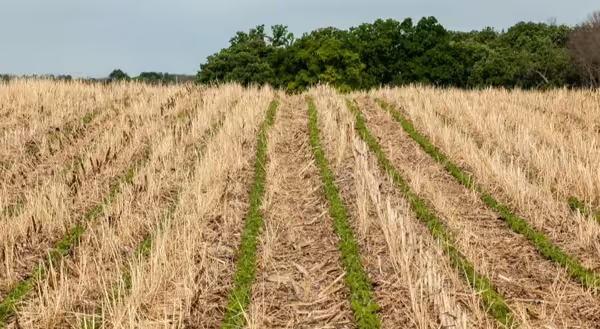
In recent years, cover crops have gained popularity as a sustainable agricultural practice that farmers can implement to improve the health and functioning of their soils. Cover crops are not a new concept, though. They used to be a normal part of our agricultural systems. It is well-documented that U.S. President George Washington was a huge promoter of cover crops in early America, stating that his crop rotations included “crops grown to eat and sell” and “crops grown to replenish the soil.” Some early cover crops that were used include clover, grasses, and buckwheat. With the rise in popularity of synthetic fertilizers and herbicides in the 1950s, cover crop use fell out of favor. Cover crops are again gaining popularity throughout the country as growers rediscover everything that they have to offer. There was a 50% increase in cover crop adoption between 2012 and 2017, but there is still only a tiny fraction of our farmland using these practices.
Cover crops can provide a wide variety of benefits, including:
- Erosion control
- Reduced soil compaction
- Increased water infiltration
- Weed suppression
- Increased soil organic matter
- Increased soil aggregation
- Reduced nutrient loss
- Nematode suppression
- Add nitrogen
- Encourage beneficial microorganisms
We hear a lot about the benefits discussed above, but there are other benefits to planting cover crops that are less discussed, including:
- Increased resource use efficiency
- Reduced reliance on nonrenewable resources
- Protect environment and reduce negative inputs
- Increased yield
- Increased resilience to extreme weather events
- Increased biodiversity
One of the most important and less discussed benefits of cover crops is that they can help improve the resiliency of our agricultural system to climate change and extreme weather events. Cover crops improve the soil’s structure and water-holding capacity, which makes it more resistant to erosion and better able to absorb heavy rain. They can also act as a living mulch, which helps retain soil moisture during drought conditions. As we’ve seen this year and in years past, rainfall is becoming more unpredictable. There are months where we don’t see any rainfall that result in mini-droughts and other months where massive storm systems are moving through every week. Continuously growing plants in our fields helps alleviate these issues. The benefits that we’ve discussed above bring greater stability and profitability to farms over time.
Want to learn more about cover crops or trouble shoot issues with fellow growers? Join us for an informal Cover Crop Roundtable Discussion on August 28, 2024 at the Marshall-Putnam Extension Office.
Emily Hansen is a Commercial Agriculture Educator with University of Illinois Extension, serving Bureau, LaSalle, Marshall, and Putnam counties. Emily provides research-based educational programs that empower growers to make sustainable choices on their farms.
Groff, S. (2015). The past, present, and future of the cover crop industry. Journal of Soil and Water Conservation, 70(6), 130A-133A. https://doi.org/10.2489/jswc.70.6.130A
Cover Crops for Sustainable Crop Rotations. SARE. https://www.sare.org/resources/cover-crops/